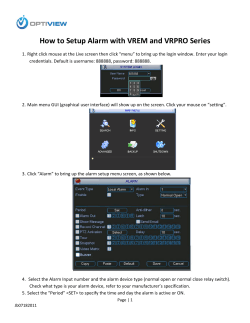
The Alarm Safety Workbook Tools to Accompany “The Alarm Safety Handbook”
The Alarm Safety Workbook Tools to Accompany “The Alarm Safety Handbook” ECRI Institute developed the tools and resources included here, along with the guidance presented in the accompanying Alarm Safety Handbook, to support alarm management teams in their efforts to improve clinical alarm safety, and thus meet the Joint Commission’s National Patient Safety Goal on Alarm Management (NPSG.06.01.01). Refer to the Handbook for additional information about using these tools within the context of an alarm management program. Editable versions of these tools and resources can be downloaded along with the electronic version of the Handbook. Contents PURPOSE AND USE 7 ECRI INSTITUTE TOOLS A. Sample Announcement from Leadership 8 B. Alarm Management Team Roster 10 C. Care Area Assessment Checklist 12 D. Nursing Staff Survey16 E. Incident-Report Review Form F. 22 Alarm Review Tool25 G. Starter List of Alarm Signals 28 H. Strategies for Reducing the Alarm Load 30 The Alarm Safety Workbook: Tools to Accompany “The Alarm Safety Handbook” Purpose and Use In developing these tools,* we focused on the Joint Commission’s 2014 requirements—that is, on the first two Elements of Performance outlined in the goal, which state: EP 1: As of July 1, 2014, leaders establish alarm system safety as a hospital priority. EP 2: During 2014, identify the most important alarm signals to manage based on the following: ZZ Input from the medical staff and clinical departments ZZ Risk to patients if the alarm signal is not attended to or if it malfunctions ZZ Whether specific alarm signals are needed or unnecessarily contribute to alarm noise and alarm fatigue ZZ Potential for patient harm based on internal incident history ZZ Published best practices and guidelines Although meeting all requirements of the goal will require effort beyond that discussed here, the intent of these tools is to assist hospitals in tackling the most immediate steps. For many hospitals, deciding how to begin may be a big challenge. meeting the goal; nor is it intended to represent the only valid path. When using these tools, keep in mind that alarm signals need to be assessed within the context of a specific care area. Staff in different care areas may consider the same alarm signal “important to manage” (as specified in the second Element of Performance) but for very different reasons. Additionally, risk associated with an alarm signal may be amplified in one care area by conditions (e.g., high alarm load) that don’t exist in another. Finally, we have not provided a tool specifically designed to solicit input from medical staff regarding the importance of alarm signals. ECRI Institute does recommend, however, that the alarm management team’s medical representative help identify alarm signals that medical staff consider important. Medical personnel should also be asked to assess the importance of (i.e., assign a rating to) alarm signals identified through the use of the tools provided here (e.g., nursing survey, review of incidents) or from other sources. Note that this material has been designed to serve as a model or starting point from which hospitals can begin to create their own alarm management programs. Hospitals can choose to adopt whichever tools will meet their needs, or they can incorporate individual elements into their own tools. In fact, we encourage hospitals to customize the information presented to develop tools tailored to their facility. This material is not intended to serve as a comprehensive, cookbook approach to * Preliminary versions of these tools were developed to complement ECRI Institute’s August 2013 web conference, “Answering the Call to Alarm Safety: Getting Ready for Joint Commission’s National Patient Safety Goal.” This material was produced by ECRI Institute’s Health Devices Group at as part of an alarm management starter kit. You may reproduce or customize this material to suit your facility’s needs. ECRI Institute assumes no liability or responsibility for how you use this document in either its original or any altered form. ©2014 ECRI Institute. 7 The Alarm Safety Workbook: Tools to Accompany “The Alarm Safety Handbook” A. Sample Announcement from Leadership INSTRUCTIONS FOR USE The first Element of Performance of NPSG.06.01.01 requires hospital leadership to establish alarm system safety as a priority. In doing so, leaders should announce the effort and communicate its importance to staff, particularly to clinical staff whose work may be affected by—and, as importantly, whose expertise may contribute to—the effort. ECRI Institute created this sample letter, which can be used in its current form (with appropriate edits) or serve as a model for a custom announcement. 8 This material was produced by ECRI Institute’s Health Devices Group at as part of an alarm management starter kit. You may reproduce or customize this material to suit your facility’s needs. ECRI Institute assumes no liability or responsibility for how you use this document in either its original or any altered form. ©2014 ECRI Institute.
© Copyright 2025





















